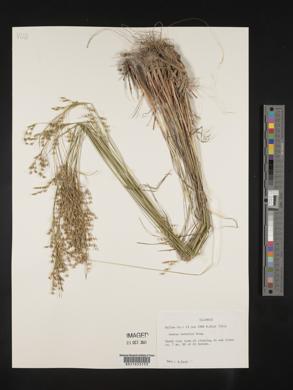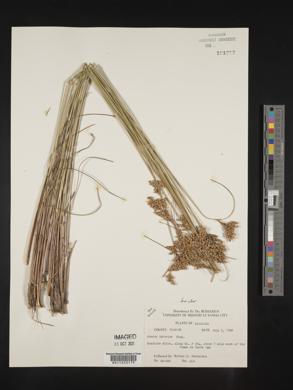Juncus interior
|
|
|
|
Family: Juncaceae
Inland Rush
[Juncus arizonicus var. curtiflorus Wiegand, moreJuncus monostichus Bartlett] |
Herbs, perennial, tufted, 2--6 dm. Rhizomes densely branching. Culms 1--10. Cataphylls 1--3. Leaves basal, 1--2(--3); auricles whitish or purplish tinged, 0.2--0.4(--0.6) mm, scarious; blade flat, 5--15 cm x 0.5--1.1 mm, margins entire. Inflorescences usually somewhat compact, 1.5--7 cm; primary bract usually shorter than inflorescence. Flowers: bracteoles 2; tepals greenish, lanceolate, 3.3--4.4 mm, apex acuminate; stamens 6, filaments 0.5--0.9 mm, anthers 0.4--0.6 mm; style 0.1--0.2 mm. Capsules light tan or darker, 1-locular to pseudo-3-locular, ellipsoid to nearly globose, (3.3--)3.8--4.7 mm, nearly equal to or longer than tepals. Seeds tan, ellipsoid to lunate, 0.436--0.73 mm, not tailed. 2n = 80. Flowering and fruiting late spring--early summer. Dry, often upland sites in prairies, exposed disturbed sites, and ditches in sandy or clayey soils; Alta., Man., Ont., Que., Sask.; Ariz., Ark., Colo., Ill., Ind., Iowa, Kans., Ky., La., Minn., Mont., Mo., Nebr., N.Mex., N.Dak., Ohio, Okla., S.Dak., Tenn., Tex.as, Utah, Wis., Wyo. Perennial grasslike forb 20 - 60 cm tall Leaves: one to three, basal, 5 - 15 cm long, 0.5 - 1.1 mm wide, linear, grasslike, flattened in cross section, and lacking crosswise partitions inside (non-septate). The leaves also have a thin and papery, whitish or faintly purplish, basal, very short (0.2 - 0.6 mm), somewhat jagged-rimmed, ear-like appendage (auricle) at the top of the leaf sheath. Inflorescence: a terminal, 1.5 - 7 cm long, somewhat compact, branched structure with several, single, short-stalked, radially symmetric, small flowers terminating very short branches. The entire branched inflorescence is subtended by a bract (usually shorter than full inflorescence), and the individual short-stalked flowers have two small bracts (bracteoles) positioned directly below the tepals. Stamens: six, with 0.5 - 0.9 mm long filaments, and slightly shorter anthers (0.4 - 0.6 mm). Pistil: with one superior ovary, a 0.1 - 0.2 mm long style, and three stigmas. Fruit: single-chambered to incompletely three-chambered, light tan or darker, 3.3 - 4.7 mm tall (about same length or longer than tepals), ellipsoid to nearly globose, short-stalked capsules. Stems: tufted, erect, smooth, round in cross section, and arising from densely branched rhizomes. Seeds: many, tan, 0.436 - 0.73 mm long, ellipsoid to crescent-shaped with short-pointed or abruptly narrowed tips, but without distinct narrowed tails at the ends. Tepals: six in two whorls of three, greenish, 3.3 - 4.4 mm long, lance-shaped with tapered, slender, pointed tips. Similar species: Juncus interior is most similar to J. dudleyi, but that species has spreading tepals when in fruit, a longer inflorescence bract (usually extending beyond inflorescence), and the leaf sheath auricles are firm, yellowish, leathery, very short (up to 0.4 mm), and have a smooth hard edge. Two other very closely related species are J. tenuis and J. anthelatus, but they both have very obvious, long, transparent, fragile, and pointed leaf sheath auricles. Although J. greenei may sometimes appear similar, it can be distinguished by its leaves which are almost round in cross section, and the capsule is three-chambered. Flowering: June to July Habitat and ecology: Uncommon, requiring dry soil, often more upland such as in prairies, but also in fairly disturbed ground such as railroad yards, and fields. Occurence in the Chicago region: native Notes: This species tends to be more common west of the Chicago Region. Author: The Field Museum FNA 2000, Wiggins 1964, Martin and Hutchins 1980, Kearney and Peebles 1969 Common Name: inland rush Duration: Perennial Nativity: Native Lifeform: Graminoid General: Tufted perennial 20-60 cm tall with densely branching and fibrous rhizomes. Vegetative: Culms 1-10, with 1-3 cataphylls, basal leaves 1-2 with auricles that are whitish or purplish tinged, 0.2-0.4 mm, scarious; blade flat, 5-15 cm long by 0.5-1 mm wide, entire margins. Inflorescence: Usually somewhat compact, 1.5-7 cm, primary bract usually shorter than inflorescence; with 2 bracteoles, greenish tepals, lanceolate, 3-4.5 mm, acuminate apex; 6 stamens with filaments 0.5-1 mm, anthers about 0.5 mm, style minute; capsules light tan or darker, 1-locular to pseudo 3-locular, ellipsoid to nearly globose, 3.5-4.5 mm, nearly equal to or longer than tepals. Ecology: Found in dry upland sites from 1,000-7,000 ft (305-2134 m); flowers June-September. Distribution: Most of eastern N. Amer.; west to AZ and north to much of CAN. Notes: Juncus species are grass-like, often occur in wetlands and have perfect flowers (with femake and male parts) with 6 brown to greenish tepals and a capsule fruit often with conspicuous stigmas coming from the top. This species easy to distinguish as a rush of dry soils; otherwise look for the perennial form; tight bunching of leaves at the base; flattened leaves, not terete; stiff auricles; inflorescence much less than half the plant and terminal (not emerging sidways from the plant); and the light colored capsule. Most recent treatments combine what were previously considered three different varieties into this single species. Ethnobotany: Unknown Etymology: Juncus comes from the Latin jungere, to join or bind, while interior means inner or on the near side, or nearer. Synonyms: None Editor: SBuckley 2010, FSCoburn 2015 From Flora of Indiana (1940) by Charles C. Deam Frequent in moist sandy clearings, prairies, fallow fields, open oak flats, and ditches. …… Indiana Coefficient of Conservatism: C = 3 Wetland Indicator Status: FAC |
|
|
|



























































































